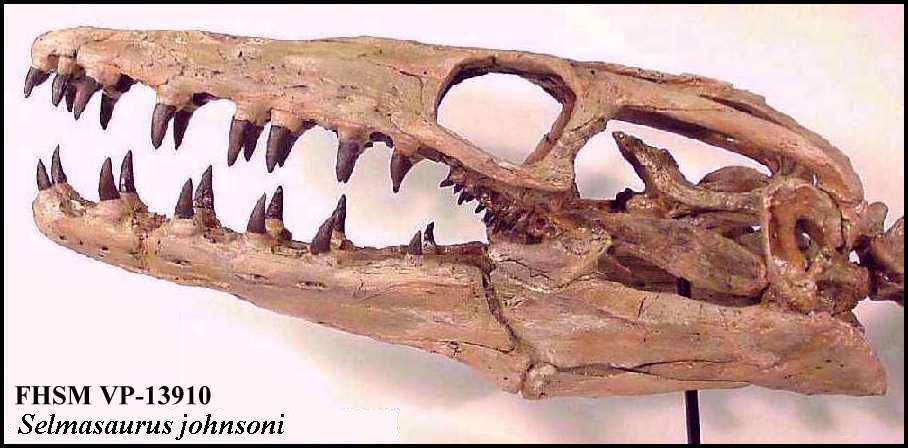
Selmasaurus johnsoni
Reconstruction of the skull
Copyright © 2001 -2009 by Mike Everhart
Last revised 03/26/2009
UNDER CONSTRUCTION
 |
Selmasaurus johnsoni Reconstruction of the skull Copyright © 2001 -2009 by Mike EverhartLast revised 03/26/2009
UNDER CONSTRUCTION
|
| IMPORTANT NOTE: The recent
publication of an article in the JVP by Takuya Konishi and Michael Caldwell clarifying the
identification and relationships of the various species of Platecarpus will
necessitate some major changes in some of my web pages. Please note that Platecarpus
planifrons Cope (1874) is now identified as the most common species of Platecarpus
in the lower chalk (late Coniacian to middle Santonian), and P. ictericus (Cope,
1871) is the most common species of this genera in upper chalk (middle Santonian through
early Campanian). P. coryphaeus (Cope, 1872) is a junior synonym of P.
ictericus. The name Platecarpus tympaniticus (Cope, 1869) is now
limited to a single specimen (holotype) from Mississippi. The species that I had
previously identified as Platecarpus planifrons (above) is now
"unidentified" and possibly a new genus / species which we are currently working
to identify / describe. I consider this paper to be a major improvement in mosasaur
phylogeny. The citation is: Konishi, T. and Caldwell, M. W. 2007. New specimens of Platecarpus planifrons (Cope, 1874) (Squamata: Mosasauridae) and a revised taxonomy of the genus: Journal of Vertebrate Paleontology 27(1): 59-72. |
In January, 2001, Steve Johnson and I talked to Mike Triebold of Triebold Paleontology about creating a 3-D skull from the bones of Steve's discovery (now Selmasaurus johnsoni). Steve was about to donate the specimen to the Sternberg Museum and wanted to have a cast made so that he would have something to keep. Mike was enthusiastic about the project and the opportunity to work with a species that so little was known about. The bones were shipped off for additional preparation, repair, and casting. In late September, 2001, the process was complete and the assembled skull was returned to Steve along with the original specimen. Meanwhile, Steve and I had submitted an abstract to the Society of Vertebrate Paleontology for the 2001 meeting in Bozeman, Montana, and it was accepted into the Poster Session. So, in early October, I loaded up a model of the skull, and the poster materials and headed off for the SVP annual meeting. A overall view of the poster is shown, along with detailed images and the abstract of the presentation. The skull was donated to the Sternberg Museum in November 2001 by Steve Johnson and was curated under catalog number FHSM 13910.
Everhart, M. J. and S. E. Johnson, 2001. The occurrence of the mosasaur, Platecarpus
planifrons, in the Smoky Hill Chalk (Upper Cretaceous) of western Kansas. Jour. Vert.
Paleon. 21(suppl. to 3):48A. Abstract
Two recently collected specimens of Platecarpus planifrons extend the range of
this uncommon mosasaur upward to the early Santonian level of the Smoky Hill Chalk Member
(second quarter of the member, below Marker Unit 7, biostratigraphic zone of Cladoceramus
undulatoplicatus) of the Niobrara Chalk. Early records of the species (more than a
dozen specimens, including the type, collected by the Cope, Marsh, and Williston parties),
although imprecise about locality and stratigraphy, appear to have been collected
primarily from Trego County, Kansas, and mostly from lower chalk exposures along Hackberry
Creek. These localities would place the species in the late Coniacian level of the Smoky
Hill Chalk Member (lowermost quarter of the chalk, below Marker Unit 5, biostratigraphic
zone of Protosphyraena perniciosa).
The type specimen in the American Museum of Natural History was originally described as 'Clidastes
planifrons'. The name stood for twenty-five years until the material was re-examined
and moved into the genus Platecarpus on the basis of characters observed in the
frontal, parietal and vertebrae. The relative rarity of the species and a lack of well
preserved, complete skeletons has contributed to a continuation of its uncertain taxonomic
position. Until resurrected in 1993 as a valid species, P. planifrons was long
considered a nomen vanum. It is far less common in the Smoky Hill Chalk Member
than P. tympaniticus (including P. ictericus and P. coryphaeus).
The early Santonian material reported here (FHSM VP-13907 and 13910) includes two partial
skeletons from Gove and Lane Counties, one with a nearly complete skull. These specimens
represent the latest known occurrence of this species and further document the temporal
distribution and diversity of the fauna in the Western Interior Sea during the late
Cretaceous.
References:
Bell, G. L. Jr., 1997. A phylogenetic revision of North American and Adriatic Mosasauroidea. pp. 293-332 In Callaway J. M. and E. L Nicholls, (eds.), Ancient Marine Reptiles, Academic Press, 501 pages.
Cope, E. D., 1874. Review of the Vertebrata of the Cretaceous period found west
of the Mississippi River. U. S. Geol. Surv. Terr. Bull.
1(2):3-48.
Everhart, M. J., 2001. Revisions to the Biostratigraphy of the Mosasauridae (Squamata) in the Smoky Hill Chalk Member of the Niobrara Chalk (Late Cretaceous) of Kansas. Kansas Academy of Science, Transactions 104(1-2):56-75.
Konishi, T. and Caldwell, M. W. 2007. New specimens of Platecarpus planifrons (Cope, 1874) (Squamata: Mosasauridae) and a revised taxonomy of the genus: Journal of Vertebrate Paleontology 27(1): 59-72.
Polcyn, M.J. and Everhart, M.J. 2008. Description and phylogenetic analysis of a new species of Selmasaurus (Mosasauridae: Plioplatecarpinae) from the Niobrara Chalk of western Kansas. Proceedings of the Second Mosasaur Meeting, Fort Hays Studies Special Issue 3, Fort Hays State University, Hays, Kansas, pp. 13-28.
Russell, D. A., 1967. Systematics and morphology of American mosasaurs. Peabody Museum of Natural History, Yale University, Bulletin 23.
Schumacher, B. A., 1993. Biostratigraphy of Mosasauridae (Squamata, Varanoidea)
from the Smoky Hill Chalk Member, Niobrara Chalk
(Upper Cretaceous) of Western Kansas, Unpub. Masters Thesis, Fort Hays State University,
68 pp.
Sheldon, M. A., 1996. Stratigraphic distribution of mosasaurs in the Niobrara Formation of Kansas, Paludicola 1:21-31. (The Rochester Institute of Vertebrate Paleontology)
Williston, S. W., 1898. Mosasaurs. The University Geological Survey of Kansas, 4:81-347, pls. 10-72.